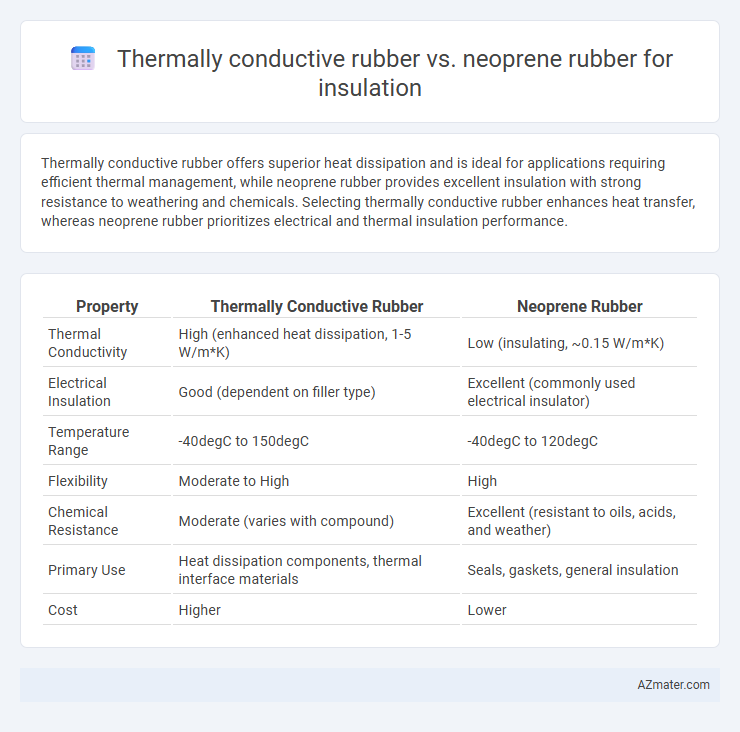Thermally conductive rubber offers superior heat dissipation and is ideal for applications requiring efficient thermal management, while neoprene rubber provides excellent insulation with strong resistance to weathering and chemicals. Selecting thermally conductive rubber enhances heat transfer, whereas neoprene rubber prioritizes electrical and thermal insulation performance.
Table of Comparison
| Property | Thermally Conductive Rubber | Neoprene Rubber |
|---|---|---|
| Thermal Conductivity | High (enhanced heat dissipation, 1-5 W/m*K) | Low (insulating, ~0.15 W/m*K) |
| Electrical Insulation | Good (dependent on filler type) | Excellent (commonly used electrical insulator) |
| Temperature Range | -40degC to 150degC | -40degC to 120degC |
| Flexibility | Moderate to High | High |
| Chemical Resistance | Moderate (varies with compound) | Excellent (resistant to oils, acids, and weather) |
| Primary Use | Heat dissipation components, thermal interface materials | Seals, gaskets, general insulation |
| Cost | Higher | Lower |
Introduction to Rubber Insulation Materials
Thermally conductive rubber offers superior heat dissipation properties compared to standard neoprene rubber, making it ideal for electronic and thermal management applications. Neoprene rubber provides excellent environmental resistance, including oil, ozone, and weathering protection, but has lower thermal conductivity. Selecting between thermally conductive rubber and neoprene rubber depends on the balance between insulation needs and heat transfer efficiency in specific industrial contexts.
Overview of Thermally Conductive Rubber
Thermally conductive rubber offers enhanced heat dissipation properties, making it ideal for applications requiring efficient thermal management and insulation. Unlike standard neoprene rubber, thermally conductive rubber contains fillers such as boron nitride or aluminum oxide, which significantly increase thermal conductivity while maintaining flexibility and electrical insulation. This material is commonly used in electronic devices, automotive components, and industrial equipment to prevent overheating and ensure reliable performance.
Properties and Applications of Neoprene Rubber
Neoprene rubber exhibits excellent thermal insulation properties due to its low thermal conductivity and resistance to temperature extremes from -40degC to 120degC, making it suitable for applications requiring durable, flexible insulation. Its chemical stability, resistance to oils, ozone, and weathering enhances its use in automotive seals, gaskets, and protective covers, where both insulation and durability are critical. Unlike thermally conductive rubber designed for heat dissipation, neoprene prioritizes thermal resistance and mechanical strength, excelling in environments demanding long-term thermal protective performance.
Heat Transfer Capabilities: Thermally Conductive vs Neoprene Rubber
Thermally conductive rubber exhibits superior heat transfer capabilities due to its enhanced thermal conductivity properties, making it ideal for applications requiring efficient heat dissipation. Neoprene rubber, with lower thermal conductivity, primarily serves as an insulator by minimizing heat transfer and providing effective thermal resistance. The contrast in heat transfer performance between these two materials determines their suitability for specific insulation or thermal management applications.
Mechanical Strength and Durability Comparison
Thermally conductive rubber exhibits superior mechanical strength and durability compared to neoprene rubber, making it ideal for applications requiring both heat dissipation and structural integrity. Its enhanced tensile strength and resistance to wear ensure longer lifespan under mechanical stress, whereas neoprene rubber offers moderate durability but lower thermal conductivity. The combination of high thermal performance and robust mechanical properties in thermally conductive rubber provides a distinct advantage for insulation in demanding industrial environments.
Flexibility and Ease of Installation
Thermally conductive rubber offers superior flexibility compared to neoprene rubber, allowing it to conform easily to irregular surfaces and complex shapes during insulation installation. Its enhanced pliability reduces installation time and effort, making it ideal for applications requiring tight sealing and consistent thermal management. Neoprene rubber, while durable and resistant to environmental factors, tends to be stiffer, which can complicate fitting and decrease ease of installation in intricate insulation projects.
Environmental Resistance and Chemical Stability
Thermally conductive rubber exhibits superior environmental resistance and chemical stability compared to neoprene rubber, making it ideal for applications exposed to harsh chemicals, extreme temperatures, and UV radiation. It resists degradation from oils, solvents, and ozone, ensuring long-term durability and consistent thermal performance. In contrast, neoprene rubber, while offering good general chemical resistance, tends to deteriorate faster under prolonged exposure to aggressive environments and high thermal stress.
Cost Analysis of Thermally Conductive Rubber vs Neoprene
Thermally conductive rubber typically incurs higher upfront costs compared to neoprene rubber due to the inclusion of fillers like graphite or ceramic particles that enhance heat dissipation. Neoprene rubber remains more cost-effective for general insulation applications, offering durability and moderate thermal resistance at a lower price point. When evaluating long-term value, thermally conductive rubber can reduce energy expenses and improve system efficiency, potentially offsetting initial expenditures despite its higher material costs.
Industry-Specific Use Cases and Suitability
Thermally conductive rubber excels in electronics and automotive industries where efficient heat dissipation is crucial to prevent component overheating and ensure operational stability. Neoprene rubber is favored in construction and HVAC applications for its superior weather resistance, flexibility, and excellent insulation against moisture and temperature extremes. Industry-specific use cases dictate the choice, with thermally conductive rubber ideal for heat-sensitive environments, while neoprene suits situations requiring durable, weather-resistant thermal barriers.
Conclusion: Choosing the Right Rubber for Insulation Needs
Thermally conductive rubber enhances heat dissipation while maintaining electrical insulation, making it ideal for applications requiring thermal management and electrical safety. Neoprene rubber offers excellent resistance to weathering, oils, and chemicals, providing durable insulation in harsh environmental conditions. Selecting between thermally conductive and neoprene rubber depends on whether thermal conductivity or environmental resistance is the critical factor for insulation performance.

Infographic: Thermally conductive rubber vs Neoprene rubber for Insulation
 azmater.com
azmater.com